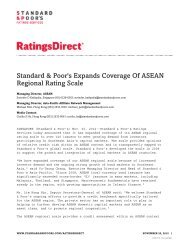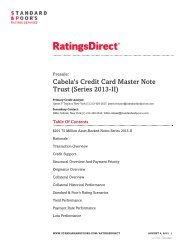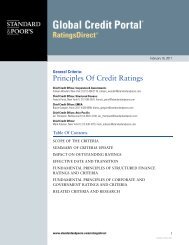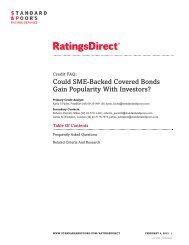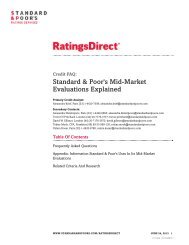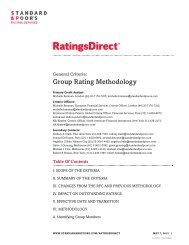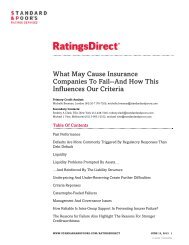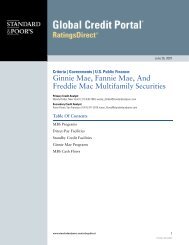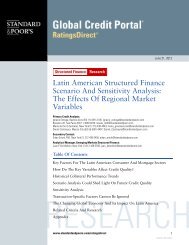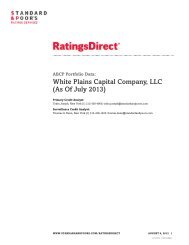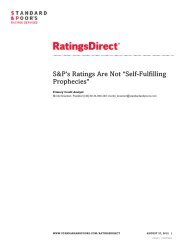Oil And Gas Companies - Standard & Poor's
Oil And Gas Companies - Standard & Poor's
Oil And Gas Companies - Standard & Poor's
You also want an ePaper? Increase the reach of your titles
YUMPU automatically turns print PDFs into web optimized ePapers that Google loves.
CreditMatters | Multimedia edition<br />
CreditWeek®<br />
The Global Authority On Credit Quality | December 14, 2011<br />
Sovereign <strong>And</strong> Bank<br />
Rating Linkages<br />
Europe’s Economy:<br />
Back In Recession<br />
Special RepoRt<br />
<strong>Oil</strong> <strong>And</strong> <strong>Gas</strong><br />
<strong>Companies</strong><br />
commodity prices aren’t<br />
the only credit Factor<br />
Eurozone Trade Balances<br />
Weigh On Growth
COVER IMAGE: CORBIS<br />
contents<br />
2 www.creditweek.com<br />
4<br />
<strong>Oil</strong> <strong>And</strong> <strong>Gas</strong> <strong>Companies</strong>: Commodity Prices Aren’t<br />
The Only Credit Factor<br />
By Thomas Watters, New York<br />
7 High <strong>Oil</strong> Prices Buoy Prospects For North American<br />
Contract Drillers’ Credit Quality<br />
By Lawrence Wilkinson, New York<br />
North American land-based drilling<br />
companies saw their balance sheets<br />
improve in 2011 as rig counts rose.<br />
Meanwhile, offshore drillers faced<br />
the third successive year of<br />
declines in profitability and credit<br />
protection measures due to rig<br />
oversupply, equipment upgrade and<br />
certification costs, and debt-financed<br />
growth activities. The credit profiles of<br />
land-based drillers should keep<br />
strengthening, with modest improvement from<br />
their offshore counterparts.<br />
9 Is Natural <strong>Gas</strong> Drilling Economic At Current Prices?<br />
By Carin Dehne-Kiley, New York<br />
December 14, 2011 | Volume 31, No. 47<br />
Special Report<br />
Despite a 75% drop in U.S. natural gas prices since mid-<br />
2008, companies continue to drill. Exploration and<br />
production companies aren’t covering their total natural<br />
gas costs with unhedged natural gas revenues. <strong>And</strong> we<br />
don’t believe they’re generating returns above their cost of<br />
capital with dry natural gas projects. <strong>Companies</strong> can drill<br />
uneconomic natural gas wells only for so long before their<br />
financial risk profiles and credit ratings begin to suffer.<br />
With a barrel of crude oil bouncing around $100 and natural gas prices<br />
mired in a long slump, it’s easy to take a simplistic view of the disparate<br />
fortunes of companies in these sectors. But a complexity of factors—<br />
from spending plans to refining margins to mergers and acquisitions—<br />
may say more about the environments in which these borrowers operate<br />
than the mere price of the commodities they produce.<br />
13 Why U.S. Refiners In The Midwest <strong>And</strong> Rockies<br />
Should Outperform Peers In 2012<br />
By Paul B. Harvey, New York<br />
U.S. refiners operating in the Midwest and Rocky<br />
Mountain regions are likely to continue to outperform<br />
refiners in U.S. coastal regions in 2012. Midwest and<br />
Rocky Mountain refiners should continue to benefit<br />
from lower crude oil costs and limited imports of<br />
refined products. By contrast, refiners on the East,<br />
West, and Gulf coasts tend to use pricier, offshore,<br />
or imported crude oil and at the same time face<br />
competition from imported refined products.<br />
16 Big Spenders: Latin America’s National <strong>Oil</strong><br />
<strong>Companies</strong>, Petrobras <strong>And</strong> PEMEX<br />
By Paula Martins, São Paulo<br />
If they were typical public companies, Petroleo Brasileiro<br />
S.A.-Petrobras and Petroleos Mexicanos might be<br />
courting criticism with their aggressive plans to spend as<br />
much as $340 billion to expand oil exploration and<br />
production. Risk is relative,<br />
however, for the two largest<br />
national oil and gas companies in<br />
Latin America. Their status as<br />
government-related entities<br />
makes them a key ingredient<br />
in Brazil’s and Mexico’s<br />
recipe for stimulating growth.
Multimedia<br />
5 Teleconference Replay: Hot Topics in the <strong>Oil</strong> &<br />
<strong>Gas</strong> Industry<br />
9 Video: Why U.S. Natural <strong>Gas</strong> <strong>Companies</strong> Continue<br />
To Drill<br />
Natural gas spot prices are hovering around $3 per<br />
thousand cubic foot (mcf). However, the cost to find,<br />
develop, and produce the gas runs at about $4.45 per mcf.<br />
So why do companies continue to drill if they can't cover<br />
their costs? In this CreditMatters TV segment, <strong>Standard</strong> &<br />
Poor’s Associate Director Carin Dehne-Kiley explains<br />
what's behind these companies' thinking. Topics include<br />
the most profitable regions, rig counts, hedging, acreage,<br />
and what the current practice could mean for companies'<br />
credit profiles.<br />
7 Video: High <strong>Oil</strong> Prices Fuel Prospects For North<br />
American Contract Drillers<br />
Overall, land-based contract drillers have enjoyed a profitable<br />
2011. But why haven't offshore drilling companies fared<br />
equally well? In this CreditMatters TV segment, <strong>Standard</strong> &<br />
Poor’s Director Larry Wilkinson examines the state of<br />
contract drillers. Topics include our expectations for landbased<br />
contract drillers, why offshore drilling has struggled,<br />
and what we expect for credit quality in 2012.<br />
13 Video: Why U.S. Refiners In The Midwest <strong>And</strong><br />
Rocky Mountains Will Outperform Peers In 2012<br />
U.S. refiners operating in the Midwest (PADD II) and Rocky<br />
Mountain (PADD IV) markets are likely to continue<br />
outperforming refiners in coastal regions next year. But will<br />
the Seaway pipeline reversal affect their success? In this<br />
CreditMatters TV segment, <strong>Standard</strong> & Poor’s Director Paul<br />
Harvey discusses how the Seaway pipeline announcement<br />
has changed PADD II and PADD IV. Topics include why we<br />
still expect the refiners to perform well, their sustainability,<br />
and the potential rating implications for the industry.<br />
16 Podcast: What’s Fueling The Investment Plans Of<br />
PEMEX <strong>And</strong> Petrobras<br />
In this podcast, <strong>Standard</strong> & Poor’s credit analysts Paula<br />
Martins and Fabiola Ortiz discuss the ambitious<br />
exploration and production plans of Petroleos Brazil and<br />
Petroleos Mexicanos. Topics include why these companies<br />
are increasing their investments, the main opportunities<br />
and challenges, and the potential ratings implications as a<br />
result of higher investments.<br />
16 Podcast: (Portugese) Por Quê A Pemex E Petrobras<br />
Vêm Aumentando Seus Investimentos<br />
Neste podcast, as analistas da <strong>Standard</strong> & Poor’s, Paula<br />
Martins discutem os ambiciosos planos de exploração e<br />
produção da Petrobras e da Pemex, suas principais<br />
oportunidades e desafios e como esses grandes<br />
investimentos podem afetar os ratings destas empresas.<br />
16 Podcast: (Spanish) Qué Está Impulsando Los<br />
Planes De Inversión De Pemex Y Petrobras<br />
En este podcast, la analista de <strong>Standard</strong> & Poor’s, Fabiola<br />
Ortiz habla sobre los ambiciosos planes de exploración y<br />
producción de Petróleos Mexicanos y Petroleo Brasilerio<br />
S.A. Los temas sobre los que comenta incluyen las<br />
razones por las que ambas petroleras están aumentando<br />
sus inversiones y sus principales oportunidades y<br />
desafíos, así como las potenciales implicaciones que las<br />
mayores inversiones podrían tener en sus calificaciones.<br />
Related Materials<br />
Click through these articles to view downloadable PDFs/Podcast<br />
Bargain Hunting: How M&A Affects North American<br />
<strong>Oil</strong> <strong>And</strong> <strong>Gas</strong> <strong>Companies</strong>’ Credit Quality<br />
By Michelle Dathorne<br />
Podcast: North American <strong>Oil</strong> <strong>And</strong> <strong>Gas</strong> <strong>Companies</strong>:<br />
How M&A Affects Credit Quality<br />
Ratings For U.S. <strong>Oil</strong> <strong>And</strong> <strong>Gas</strong> Are Stable, Despite<br />
Economic Woes<br />
By Thomas Watters<br />
Key Credit Factors: Criteria For Rating The Global <strong>Oil</strong><br />
Refining Industry<br />
By Scott Sprinzen and Thomas Watters<br />
Natural <strong>Gas</strong> Price Assumptions for 2012 <strong>And</strong> 2013<br />
Revised; 2014 <strong>Oil</strong> <strong>And</strong> Natural <strong>Gas</strong> Assumptions Added<br />
By Thomas Watters<br />
<strong>Standard</strong> & Poor’s CreditWeek | December 14, 2011 3
features special report<br />
4 www.creditweek.com
<strong>Oil</strong> <strong>And</strong> <strong>Gas</strong> <strong>Companies</strong><br />
Commodity Prices Aren’t The<br />
Only Credit Factor<br />
With a barrel of crude oil bouncing around $100 and<br />
natural gas prices mired in a long slump, it’s easy to<br />
take a simplistic view of the disparate fortunes of<br />
companies in these sectors. But a complexity of factors—<br />
from spending plans to refining margins to mergers and<br />
acquisitions—may say more about the environments in which<br />
these borrowers operate than the mere price of the<br />
commodities they produce.<br />
<strong>Standard</strong> & Poor’s CreditWeek | December 14, 2011 5
features special report<br />
6 www.creditweek.com<br />
Naturally, global integrated exploration<br />
and production (E&P) companies<br />
that concentrate on oil are benefiting<br />
greatly from sustained high<br />
crude prices, as are the service<br />
providers that support drilling and<br />
production. <strong>And</strong> just as clearly, the<br />
sharp decline in the price of natural<br />
gas since mid-2008 has created certain<br />
hurdles for E&P companies focused<br />
on that sector. At the same time,<br />
<strong>Standard</strong> & Poor’s Ratings Services<br />
believes this view only begins to<br />
describe the opportunities and challenges<br />
in the oil and gas industry.<br />
We expect credit quality for the U.S. oil and<br />
gas sector to remain relatively stable into<br />
2012, despite a still-fragile economic recovery.<br />
For example, investment grade (rated<br />
‘BBB-’ or higher), integrated North<br />
American oil and gas companies continue<br />
to adjust their portfolios of assets<br />
by selling low-value, low-return properties<br />
or businesses (such as refineries). As<br />
a result, borrowers with broadly diversified<br />
operations can use the proceeds to<br />
finance investments in other business<br />
units or to achieve higher internal rates<br />
of return. Meanwhile, companies with<br />
the operational and financial flexibility<br />
to capitalize on industry cycles are<br />
making opportunistic purchases at reasonable<br />
prices.<br />
Moreover, some smaller, speculative-grade<br />
(rated ‘BB+’ or lower) firms<br />
are also taking advantage of favorable<br />
capital markets—and interest rates—<br />
to increase their oil and gas production<br />
through acquisitions. <strong>Companies</strong><br />
with some financial cushion or a willingness<br />
to use both equity and debt to<br />
finance acquisitions will suffer fewer<br />
negative effects on their creditworthiness<br />
than those with comparatively<br />
weak liquidity and high levels of debt,<br />
in our view.<br />
Meanwhile, natural gas E&P companies<br />
may not be sufficiently covering<br />
their all-in costs for natural gas.<br />
<strong>And</strong> we believe companies can only<br />
drill uneconomic natural gas wells for<br />
so long before suffering damage to<br />
their financial risk profiles and, as<br />
a result, to their credit ratings.<br />
Although many companies are shifting<br />
their spending to oil and liquefied natural<br />
gas, getting such production running<br />
may take longer and cost more<br />
than they anticipate.<br />
Alternatively, demand for drilling<br />
services looks set to remain healthy in<br />
2012. Increasing demand from oilfocused<br />
players should continue to<br />
more than offset declines related to natural<br />
gas, benefiting the performance of<br />
onshore contract drilling companies.<br />
All told, we expect credit quality for<br />
the U.S. oil and gas sector to remain<br />
relatively stable into 2012, despite a<br />
still-fragile economic recovery. We<br />
believe that a gradually strengthening<br />
economy will help keep oil prices<br />
close to $100 a barrel, as well as marginally<br />
higher prices for natural gas.<br />
Still, our base-case forecast calls for<br />
mild economic growth, with real GDP<br />
expanding 1.9% next year—though<br />
we put the chance of slipping back<br />
into recession at 35%.<br />
High oil prices often translate into<br />
consumers spending more on energy<br />
and less on discretionary items. This<br />
could hurt retailers and other sectors<br />
that depend heavily on consumers. As a<br />
result, these businesses may lay off<br />
workers, which keeps unemployment<br />
high and puts an even tighter squeeze<br />
on consumers. Still, we believe the price<br />
of oil would have to surge to around<br />
$150 a barrel to plunge the U.S. back<br />
into recession on its own, and we don’t<br />
expect high oil prices to do significant<br />
damage to the recovery. CW<br />
For more articles on this topic search RatingsDirect with keyword:<br />
<strong>Oil</strong> and <strong>Gas</strong><br />
Analytical Contact:<br />
Thomas Watters<br />
New York (1) 212-438-7818
High <strong>Oil</strong> Prices Buoy Prospects For North<br />
American Contract Drillers’ Credit Quality<br />
With crude oil averaging above<br />
$90 a barrel and exploration<br />
and production (E&P) companies<br />
demanding more (and more-varied)<br />
drilling services, 2011 has been a busy<br />
year for North American drilling companies.<br />
However, the financial effects in the<br />
contract drilling sector have been uneven.<br />
Land-based drillers saw their balance<br />
sheets improve as rig counts rose.<br />
Meanwhile, offshore drillers faced rig oversupply<br />
and equipment upgrade and certification<br />
costs, which, coupled with debtfinanced<br />
growth activities, made 2011 the<br />
third successive year of declines in profitability<br />
and credit protection measures.<br />
<strong>Standard</strong> & Poor’s Ratings Services<br />
expects demand for drilling services in<br />
2012 to continue to rise. We believe the<br />
credit profiles of land-based drillers will<br />
keep strengthening, albeit at a slower pace,<br />
and we expect more modest improvement<br />
from their offshore counterparts.<br />
Land-Based Drillers Continue To<br />
Witness A Shift To <strong>Oil</strong> From <strong>Gas</strong><br />
Onshore contract drilling companies’ performance<br />
continues to strengthen, with<br />
increasing demand from oil-directed plays<br />
more than offsetting declines for natural<br />
gas. High oil prices have led E&P companies<br />
to spend more toward developing<br />
acreage in unconventional shale plays, such<br />
as the Bakken play in North Dakota and<br />
the Eagle Ford and Wolfberry plays in<br />
Texas. As a result, as of Nov. 18, 2011,<br />
overall oil rig counts had risen over 50%<br />
over the same time last year. At the same<br />
Overview<br />
■ Rising rig counts have benefited<br />
land-based drillers this year. We<br />
expect their credit profiles to keep<br />
improving in 2012, but at a slower<br />
pace than we’ve seen this year.<br />
■ High oil prices continue to fuel a<br />
shift in exploration and production<br />
to oil and away from natural gas.<br />
■ For offshore drillers, we expect<br />
rising day rates and utilization to<br />
lead to moderately better financial<br />
performance in 2012.<br />
<strong>Standard</strong> & Poor’s CreditWeek | December 14, 2011 7
features special report<br />
time, weak natural gas prices have resulted<br />
in a slight pullback in development of those<br />
assets. The number of natural gas-directed<br />
rigs has declined by slightly more than 10%<br />
compared with the prior year (see chart 1).<br />
The net impact of these two trends<br />
has been a roughly 20% year-over-year<br />
increase in land-based rig counts, to<br />
more than 2,000 units (see chart 2).<br />
Onshore Drillers’ Financial<br />
Performance Will Likely Keep<br />
Improving In 2012<br />
We expect onshore contract drillers’ credit<br />
profiles to continue to improve in 2012,<br />
albeit at a slower pace than we’ve seen this<br />
year. Given the current favorable outlook<br />
for oil prices, oil drilling will likely continue<br />
to offset declining natural gas rig counts.<br />
Drillers will likely see continued strong rig<br />
Chart 1 Rig Count<br />
<strong>Oil</strong> and gas<br />
1,200<br />
1,100<br />
1,000<br />
900<br />
800<br />
700<br />
600<br />
500<br />
<strong>Oil</strong> <strong>Gas</strong><br />
8 www.creditweek.com<br />
utilization and even some further strengthening<br />
of day rates in the first half of the year.<br />
However, the cost of newly built rigs scheduled<br />
for delivery in 2012, coupled with the<br />
displacement of some rigs from natural gas<br />
basins, will likely limit these gains.<br />
For Nabors Industries Inc. (BBB/Stable/—)<br />
and Pioneer Drilling Co.<br />
(B/Stable/—), continued gains in both utilization<br />
and day rates—along with new<br />
rigs and equipment coming on line and<br />
charging day rate—will likely boost their<br />
credit protection measures. However, the<br />
higher costs required for upgrades and<br />
new fleet additions may temper these<br />
improvements somewhat. In the case of<br />
Precision Drilling Corp., we believe that<br />
the pace of debt-financed rig additions<br />
could leave the company challenged to<br />
400<br />
January 2010 May 2010 September 2010 January 2011 May 2011 September 2011<br />
Source: Baker Hughes Inc.<br />
© <strong>Standard</strong> & <strong>Poor's</strong> 2011.<br />
Chart 2 Rig Counts<br />
Total onshore and offshore<br />
2,200<br />
2,000<br />
1,800<br />
1,600<br />
1,400<br />
1,200<br />
1,000<br />
Jan. 2010 April 2010 July 2010 Oct. 2010 Jan. 2011 April 2011 July 2011 Oct. 2011<br />
Source: Baker Hughes Inc.<br />
© <strong>Standard</strong> & Poor’s 2011.<br />
preserve credit protection measures at<br />
levels consistent for the current rating.<br />
Most Offshore Drillers’ Credit<br />
Measures Deteriorated In 2011,<br />
But 2012 Looks More Promising<br />
Coming off a peak in 2008, offshore contract<br />
drillers—such as Diamond Offshore<br />
Drilling Inc. (A-/Stable/—), Noble Corp.<br />
(BBB+/Stable/—), Ensco PLC (BBB+/Negative/A-2),<br />
and Transocean Inc. (BBB-/Negative/A-3)—have<br />
seen successive declines<br />
in profitability and credit protection measures.<br />
While rig oversupply and the resulting<br />
erosion in day rates and utilization have<br />
played a role, other factors have been influential<br />
as well. Post-Macondo safety and<br />
equipment standards have resulted in more<br />
out-of-service time and greater maintenance<br />
expenditures than many issuers<br />
expected. Furthermore, a number of offshore<br />
drillers have contracted for new rigs<br />
or funded acquisitions without equity. The<br />
net impact has been a significant erosion of<br />
credit quality for many issuers in the sector.<br />
Nonetheless, we anticipate moderately<br />
better financial performance for offshore<br />
contract drillers over the course of 2012.<br />
Continued strong oil pricing and the<br />
resulting E&P demand, a drop in the<br />
number of new rigs coming on line, and<br />
limited availability of high-specification<br />
floating rigs all bode well for these companies.<br />
While day rates for floating rigs have<br />
stabilized over the last several quarters,<br />
day rates for jackup rigs (offshore rigs with<br />
retractable legs) have shown sequential<br />
improvement. The tightening in overall rig<br />
supply will likely boost day rates and utilization<br />
for offshore contract drillers in<br />
2012. Although there may be pockets of<br />
weakness for lower-specification rigs,<br />
overall credit quality should improve as<br />
the benefits of a tighter market and earnings<br />
from recent fleet additions begin to<br />
show up in the companies’ results. CW<br />
For more articles on this topic search RatingsDirect with keyword:<br />
Drillers<br />
Analytical Contacts:<br />
Lawrence Wilkinson<br />
New York (1) 212-438-1882<br />
Paul B. Harvey<br />
New York (1) 212-438-7696
Is Natural <strong>Gas</strong> Drilling<br />
Economic At Current Prices?<br />
Despite a 75% drop in U.S. natural<br />
gas prices since mid-2008, companies<br />
continue to drill. The spot<br />
price for gas, as measured by the Henry<br />
Hub benchmark, has declined to about<br />
$3.35 per million Btu (MMBtu) today,<br />
from its peak of $13.00 per MMBtu in<br />
mid-2008, with the 12-month strip price<br />
at about $3.70 per MMBtu. The natural<br />
gas-weighted U.S. exploration and production<br />
(E&P) companies we rate spent<br />
an average of $3.35 per thousand cubic<br />
feet equivalent (Mcfe) in the second<br />
quarter of 2011 to find, develop, and<br />
produce natural gas ($4.45 per Mcfe<br />
including interest costs). Based on these<br />
numbers, E&P companies are not covering<br />
their total natural gas costs with<br />
unhedged natural gas revenues. <strong>And</strong> we<br />
don’t believe they are generating returns<br />
above their cost of capital (10%) with<br />
most dry natural gas projects. We<br />
believe that companies can drill uneconomic<br />
natural gas wells only for so long<br />
before their financial risk profiles and,<br />
thus their credit ratings, begin to suffer.<br />
Recent trends in U.S. drilling activity<br />
support our conclusions. Since reaching<br />
Overview<br />
■ We don’t believe E&P companies<br />
are covering their total costs for dry<br />
natural gas production with<br />
unhedged revenues.<br />
■ <strong>Companies</strong> are also shifting their<br />
capital investments toward oil and<br />
NGL drilling.<br />
■ Our ratings on natural gas-focused<br />
E&P companies could come under<br />
pressure.<br />
<strong>Standard</strong> & Poor’s CreditWeek | December 14, 2011 9
features special report<br />
Chart 1 U.S. <strong>Oil</strong> <strong>And</strong> Natural <strong>Gas</strong> Rig Count<br />
1,800<br />
1,600<br />
1,400<br />
1,200<br />
1,000<br />
800<br />
600<br />
400<br />
200<br />
0<br />
<strong>Oil</strong> rigs Natural gas rigs<br />
1/7/2005<br />
4/7/2005<br />
Source: Baker Hughes Inc.<br />
© <strong>Standard</strong> & Poor’s 2011.<br />
10 www.creditweek.com<br />
a peak of 1,600 in September 2008, the<br />
number of rigs actively drilling for natural<br />
gas in the U.S. is down 45%—to<br />
about 865 currently. By contrast, over<br />
the same period, the number of rigs<br />
drilling for oil in the U.S. nearly tripled<br />
to more than 1,100 (see chart 1). <strong>And</strong><br />
almost every E&P company is shifting<br />
capital to oil or natural gas liquids<br />
(NGLs) and away from dry natural gas.<br />
Even so, many E&P operators say<br />
their own gas fields are generating at<br />
least a 10% rate of return. We believe<br />
most such economic returns are associated<br />
with unconventional natural gas<br />
shales. Compared with conventional<br />
plays, shale reservoirs tend to be more<br />
uniform across a broad area and therefore<br />
generally carry lower exploration<br />
risk. Shale reservoirs have other differences<br />
compared with conventional gas<br />
fields. Those include higher initial production<br />
(IP) rates relative to estimated<br />
ultimate recoveries, hyperbolic production<br />
decline curves, and long reserve<br />
lives. <strong>And</strong> because most shales are<br />
developed using horizontal drilling and<br />
fracture stimulation, initial well costs<br />
tend to be greater for unconventional<br />
than conventional wells.<br />
<strong>Oil</strong> <strong>And</strong> NGL Assets<br />
Produce Better Returns<br />
To estimate the internal rates of return<br />
(IRR) of major gas shale assets, we used<br />
average well data from public sources<br />
7/7/2005<br />
10/7/2005<br />
1/7/2006<br />
4/7/2006<br />
7/7/2006<br />
10/7/2006<br />
1/7/2007<br />
4/7/2007<br />
7/7/2007<br />
10/7/2007<br />
1/7/2008<br />
4/7/2008<br />
7/7/2008<br />
10/7/2008<br />
1/7/2009<br />
4/7/2009<br />
7/7/2009<br />
10/7/2009<br />
1/7/2010<br />
4/7/2010<br />
7/7/2010<br />
10/7/2010<br />
1/7/2011<br />
4/7/2011<br />
7/7/2011<br />
10/7/2011<br />
and our commodity price assumptions.<br />
Our current natural gas price assumption<br />
is $3.75/MMBtu in 2012, $4.00<br />
per MMBtu in 2013, and $4.50 per<br />
MMBtu thereafter for the Henry Hub<br />
benchmark. Our deck for West Texas<br />
Intermediate (WTI) spot crude oil is<br />
$80 per barrel (bbl) in 2012 and $70<br />
per bbl thereafter, with the price of<br />
NGLs at 55% of WTI. We estimate<br />
that at those prices most dry gas assets<br />
(those with no associated oil or NGLs)<br />
would generate less than a 10% IRR<br />
(see chart 2). These include the<br />
Woodford shale (Oklahoma), the<br />
Piceance Basin (Rockies), the non-core<br />
Haynesville/Bossier shales (East<br />
Texas), the Eagle Ford dry gas area<br />
(South Texas), the Marcellus dry gas<br />
area (Northeast Pennsylvania), the<br />
Barnett shale (Central Texas), and the<br />
Fayetteville shale (Arkansas). The<br />
exception to this is the “core” area of<br />
the Haynesville shale in North<br />
Louisiana, which we estimate generates<br />
around a 12% IRR, because of<br />
significantly above-average IP rates.<br />
By contrast, gas reserves that include<br />
even a small oil or NGL component are<br />
generating more than a 10% rate of<br />
return, based on our price assumptions.<br />
These include the Cana-Woodford shale<br />
(Oklahoma), the Marcellus wet gas area<br />
(Southwest Pennsylvania), the Eagle<br />
Ford oil and liquids rich areas (South<br />
Texas), and the Granite Wash formations<br />
(Oklahoma/Texas). The latter<br />
jumps out with a 22% IRR, but this<br />
area carries more exploration risk<br />
because it is not a uniform shale. We<br />
also included a pure oil asset—the<br />
Bakken shale in North Dakota—in<br />
our study. The core Bakken shale generates<br />
almost a 40% IRR, which is<br />
not surprising given that WTI spot oil<br />
prices are trading at over 25x the spot<br />
price of natural gas (on an energy<br />
equivalent basis).<br />
We also evaluated how a 10%<br />
change in different variables could<br />
affect our IRR calculation (see table<br />
and chart 3). Our calculation is most<br />
affected by a change in the first year<br />
production decline rate, followed by a<br />
change in well cost, a well’s IP rate,
and, finally, the first year natural gas<br />
price. A shift in production taxes, operating<br />
costs, and reductions in estimated<br />
ultimate recoveries had less of an effect<br />
on the IRR calculation.<br />
Natural <strong>Gas</strong> Production Costs<br />
Are Likely To Stay Flat Next Year<br />
We estimate that average all-in per-unit<br />
costs (for companies with a 75% or<br />
more weighting to natural gas) have<br />
decreased by about 15% since 2008.<br />
All-in costs include finding and development<br />
(F&D), lifting, production taxes,<br />
cash general and administrative (G&A)<br />
expense, and interest (including capitalized<br />
interest). Because E&P companies<br />
do not typically provide cost allocations<br />
between oil and natural gas, we looked<br />
at companies whose proven reserves are<br />
more than 75% natural gas as a proxy<br />
for natural gas costs. F&D costs for<br />
these companies averaged $1.55 per<br />
Mcfe, cash operating costs averaged<br />
about $1.80 per Mcfe, and interest<br />
costs were $1.10/Mcfe in the second<br />
quarter of 2011. F&D costs have<br />
declined about 15%, on average, since<br />
2008 because of improved drilling tech-<br />
Key Assumptions In Internal Rates Of Return Calculation<br />
niques and the booking of proved undeveloped<br />
locations, while operating costs<br />
have remained about flat. Although we<br />
believe operators will continue to<br />
increase efficiency, especially as they<br />
move into full development of the<br />
shales, we think more industry activity<br />
in the oil and NGL-rich areas will continue<br />
to put upward pressure on service<br />
costs. Thus, we are assuming flat costs<br />
for next year.<br />
Based on unhedged revenues for the<br />
second quarter of 2011, we estimate<br />
the recycle ratio for natural gas<br />
drilling averaged 1.5x. We define the<br />
recycle ratio as the cash flow generated<br />
per Mcfe of natural gas produced<br />
divided by per-unit F&D costs. In<br />
other words, for every $1 per Mcfe<br />
invested, companies generated $1.50<br />
per Mcfe of cash. It’s important to<br />
recall, however, that Henry Hub natural<br />
gas prices averaged $4.36 per<br />
MMBtu in the second quarter of 2011;<br />
currently they are running at close to<br />
$3.35 per MMBtu, with the 12-month<br />
strip at $3.70 per MMBtu. Based on<br />
our price assumptions of $3.75 per<br />
MMBtu in 2012 and assuming all-in<br />
Internal Gross estimated Production Production<br />
rates of ultimate % oil/ Gross IP rate First year Well cost Royalty taxes (% cost<br />
return (%) recoveries (Bcfe) liquids (Mmcfe/d) decline (%) (mil. $) rate (%) of revenue) ($/Mcfe)<br />
Bakken (core) 39 4.2 100 6.6 65 6.5 20 12 1.67<br />
Granite Wash (liquids rich) 22 4.0 55 8.0 65 9.0 15 8 1.50<br />
Bakken (non-core) 15 3.6 100 5.4 65 8.5 20 12 1.67<br />
Eagle Ford (liquids rich) 10 3.0 70 6.0 75 9.0 25 8 1.00<br />
Eagle Ford (oil) 10 2.4 78 4.8 75 9.0 25 8 1.00<br />
Marcellus (liquids rich) 11 6.0 27 4.5 65 6.0 13 5 1.06<br />
Cana-Woodford 11 7.5 38 5.5 55 8.0 20 7 1.00<br />
Haynesville (core) 12 10.0 0 15.0 81 9.0 25 8 0.70<br />
Fayetteville 5 3.0 0 3.3 63 3.0 20 4 1.00<br />
Barnett 5 3.0 0 2.9 60 2.8 20 3 1.00<br />
Marcellus (dry gas) 3 6.0 0 4.5 65 6.0 13 5 1.06<br />
Eagle Ford (dry gas) 3 6.0 0 10.9 80 8.0 25 8 1.00<br />
Haynesville (non-core) N.M. 7.5 0 6.0 81 8.0 25 8 0.70<br />
Piceance N.M. 0.9 0 1.7 60 1.9 19 6 0.97<br />
Woodford N.M. 4.0 0 4.5 60 7.0 19 7 0.70<br />
N.M.—Not meaningful. Bcfe—Billion cubic feet equivalent. Mcfe—Thousand cubic feet equivalent. Mmcfe/d—Million cubic feet equivalent per day.<br />
Source: <strong>Standard</strong> & Poor’s.<br />
<strong>Standard</strong> & Poor’s CreditWeek | December 14, 2011 11
features special report<br />
Chart 2 Internal Rates of Return* Of Major Shale Plays<br />
(%)<br />
45<br />
40<br />
35<br />
30<br />
25<br />
20<br />
15<br />
10<br />
5<br />
0<br />
(basis points)<br />
1,000<br />
900<br />
800<br />
700<br />
600<br />
500<br />
400<br />
300<br />
200<br />
100<br />
0<br />
Bakken–core<br />
First year decline<br />
Granite Wash–liquids rich<br />
Source: <strong>Standard</strong> & Poor’s.<br />
© <strong>Standard</strong> & Poor’s 2011.<br />
Well cost<br />
Bakken–non-core<br />
Haynesville–core<br />
IP rate<br />
12 www.creditweek.com<br />
Marcellus–liquids rich<br />
Year 1<br />
natural gas price<br />
costs of $4.45 per Mcfe, we estimate<br />
the natural gas recycle ratio would<br />
drop below 1x on an unhedged basis<br />
next year. A ratio below 1x implies a<br />
money-losing project.<br />
Why Are <strong>Companies</strong> Still<br />
Drilling For Natural <strong>Gas</strong>?<br />
There are several reasons why E&P<br />
companies are still drilling for natural<br />
Chart 3 Impact Of Various Factors On Internal Rates Of Return<br />
Cana-Woodford<br />
*IRR calculation is based on Henry Hub natural gas prices of $3.75 per MMBtu in 2012, $4 in 2013, and $4.5 thereafter; WTI crude oil prices<br />
of $80 per barrel (bbl) for 2012 and $70 per bbl thereafter; and natural gas liquids (NGL) prices of 55% of WTI.<br />
Source: <strong>Standard</strong> & Poor’s.<br />
© <strong>Standard</strong> & Poor’s 2011.<br />
LT natural gas price<br />
Eagle Ford–liquids rich<br />
Eagle Ford–oil<br />
Royalty rate<br />
Fayetteville<br />
Production taxes<br />
Barnett<br />
Production cost<br />
Marcellus–dry gas<br />
Eagle Ford dry gas<br />
Estimated<br />
ultimate recoveries<br />
gas and, therefore, why U.S. natural gas<br />
production continues to increase,<br />
including:<br />
■ Hedges they have in place on natural<br />
gas production (though hedges are<br />
starting to roll off next year);<br />
■ A requirement to drill if they want to<br />
hold onto acreage under term leases<br />
(although this was mainly a<br />
Haynesville shale phenomenon and is<br />
starting to wind down);<br />
■ A project’s natural gas stream<br />
includes some component of oil or<br />
NGLs;<br />
■ Joint venture partners who have<br />
deeper pockets or more strategic reasons<br />
for drilling (such as acquiring<br />
shale drilling expertise);<br />
■ A reluctance to announce production<br />
cuts because of shareholder response;<br />
■ First movers in certain plays enjoy<br />
lower costs (because they acquired<br />
acreage before the area became competitive<br />
and are likely in the most<br />
prolific area of the play);<br />
■ A belief that costs will be lower in the<br />
future (because of greater drilling efficiencies<br />
or falling costs for oilfield<br />
services); and<br />
■ A belief that natural gas prices will be<br />
higher in the future.<br />
Nevertheless, we believe that companies<br />
can drill uneconomic natural<br />
gas wells only for so long before their<br />
financial risk profiles and thus, their<br />
credit ratings, begin to suffer. How<br />
long that will take will depend on<br />
each company’s financial risk profile,<br />
including its debt leverage, liquidity,<br />
and the amount of natural gas production<br />
it has hedged. Although E&P<br />
companies are shifting spending to<br />
oil and NGLs, starting and increasing<br />
production from these oil projects<br />
could take longer and cost more than<br />
they anticipate, putting additional<br />
near-term stress on their financial<br />
risk profiles. CW<br />
For more articles on this topic search RatingsDirect with keyword:<br />
Drilling<br />
Analytical Contact:<br />
Carin Dehne-Kiley<br />
New York (1) 212-438-1092
Why U.S. Refiners In The Midwest<br />
<strong>And</strong> Rockies Should Outperform<br />
Peers In 2012<br />
U.S. refiners operating in the Midwest<br />
(PADD II) and Rocky Mountain<br />
(PADD IV) regions are likely to continue<br />
to outperform refiners in U.S. coastal<br />
regions in 2012. (In the 1940s, government<br />
agencies that no longer exist<br />
divided the U.S. into five Petroleum<br />
Administration for Defense Districts, or<br />
PADDs. In industry parlance, the Midwest<br />
and Rockies regions are PADD II and IV.<br />
PADDS I, III, and V include refiners on the<br />
East, Gulf, and West coasts.)<br />
Midwest and Rocky Mountain refiners<br />
should continue to benefit from lower<br />
crude oil costs and limited imports of<br />
refined products. In particular, these<br />
refiners are expected to benefit from their<br />
use of West Texas Intermediate (WTI)<br />
crude oil, which as of Nov. 23 averaged<br />
about $8.25 per barrel less than North<br />
Sea Brent crude (see chart 1). Moreover,<br />
these companies can also refine the rising<br />
flow of crude from the Bakken Shale oil<br />
field in North Dakota and Montana,<br />
which we expect to price at a discount to<br />
WTI—given the still limited capacity to<br />
take production out of the region. We<br />
also expect these refiners to benefit from<br />
Overview<br />
■ U.S. refiners operating in the<br />
Midwest and Rockies have an<br />
advantage over their peers in coastal<br />
regions because they have access to<br />
lower-priced crude.<br />
■ We expect this situation to persist at<br />
least through next year.<br />
■ Nevertheless, we expect our ratings<br />
on these refiners to remain stable<br />
despite their higher margins.<br />
<strong>Standard</strong> & Poor’s CreditWeek | December 14, 2011 13
features special report<br />
14 www.creditweek.com<br />
the flow of Canadian crude oil grades,<br />
particularly discounted heavy grades,<br />
into the PADD II and IV regions, which<br />
have lower transportation costs.<br />
By contrast, refiners on the East,<br />
West, and Gulf coasts tend to use<br />
pricier, offshore, or imported crude oil,<br />
and at the same time face competition<br />
from imported refined products—both<br />
of which hurt their margins relative to<br />
refiners in inland regions. That said, we<br />
currently don’t expect, within the next<br />
12 months, to raise our credit ratings<br />
on Midwest and Rockies refining companies—such<br />
as Flint Hills Resources<br />
LLC (A+/Stable/A-1), HollyFrontier<br />
Corp. (BB+/Stable/—), and Marathon<br />
Petroleum Corp. (BBB/Stable/A-2)—<br />
despite their higher profits.<br />
Chart 1 Future Brent-WTI Crude Price Differential<br />
($/bbl)<br />
Brent (left scale) WTI (left scale) Brent-WTI Differential (right scale)<br />
Price Gaps Are Not Likely To<br />
Widen Considerably<br />
To be sure, we currently don’t expect the<br />
price difference between WTI and Brent<br />
to widen much if any in 2012. On Nov.<br />
16, 2011, Enbridge Inc. (A-/Stable/—)<br />
and Enterprise Products Partners L.P.<br />
(BBB-/Positive/—) announced that they<br />
would reverse flows in the Seaway<br />
pipeline and transport crude oil from<br />
Cushing, Okla. to Nederland, Texas,<br />
reducing the glut at Cushing. As a result<br />
of that announcement, the WTI-Brent<br />
price difference narrowed by 30% to<br />
$9.30/bbl from about $13 per barrel (bbl)<br />
(see chart 2). Meanwhile, TransCanada<br />
Corp. (A-/Stable/—) has announced that it<br />
will seek permits to construct the southern<br />
leg of the Keystone XL pipeline from<br />
110<br />
108<br />
8.8<br />
106<br />
8.4<br />
104<br />
102<br />
8.0<br />
100<br />
7.6<br />
98<br />
7.2<br />
96<br />
94<br />
92<br />
6.8<br />
6.4<br />
90<br />
Jan. 2012 March 2012 May 2012 July 2012 Sept. 2012 Nov. 2012 Jan. 2013<br />
6.0<br />
March 2013<br />
As of Dec. 5, 2011.<br />
Source: Bloomberg.<br />
© <strong>Standard</strong> & Poor’s 2011.<br />
Chart 2 Brent-WTI Crude Price Differential<br />
($/bbl)<br />
30<br />
25<br />
20<br />
15<br />
10<br />
5<br />
0<br />
1/2/2011<br />
2/2/2011<br />
As of Dec. 5, 2011.<br />
Source: Bloomberg.<br />
© <strong>Standard</strong> & Poor’s 2011.<br />
3/2/2011<br />
4/2/2011<br />
5/2/2011<br />
6/2/2011<br />
7/2/2011<br />
8/2/2011<br />
9/2/2011<br />
10/2/2011<br />
11/2/2011<br />
($/bbl)<br />
12/2/2011
Chart 3 Future Brent-WTI 3-2-1 Crack Spreads<br />
($/bbl)<br />
Brent 3:2:1 WTI 3:2:1<br />
20<br />
18<br />
16<br />
14<br />
12<br />
10<br />
8<br />
6<br />
4<br />
2<br />
0<br />
Jan. 2012 March 2012 May 2012 July 2012 Sept. 2012 Nov. 2012 Jan. 2013 March 2013<br />
As of Dec. 5, 2011.<br />
Source: Bloomberg.<br />
© <strong>Standard</strong> & Poor’s 2011.<br />
The narrowing of the price differential likely<br />
doesn’t mean an end to the advantage<br />
Midwest and Rockies refiners enjoy.<br />
Cushing to the Gulf Coast—giving refiners<br />
there access to the cheaper crude oil grades.<br />
Enbridge expects to reverse Seaway’s flows<br />
by the second quarter of 2012, expanding<br />
shipments to the Gulf to 400,000 barrels<br />
per day (bpd) by early 2013 from 150,000<br />
bpd initially. This should allow Gulf Coast<br />
refiners to reduce use of imported crude oil<br />
grades and benefit from the use of less<br />
expensive North American crude grades.<br />
The narrowing of the price differential<br />
likely doesn’t mean an end to the advantage<br />
Midwest and Rockies refiners enjoy,<br />
however. Based on futures contracts, we<br />
expect the Brent-WTI differential to<br />
average around $8.25 per barrel in 2012<br />
(see chart 3). Although the Seaway reversal<br />
will help alleviate the glut of oil at Cushing<br />
refineries, the initial 150,000 bpd capacity<br />
falls short of what’s needed to end the bottleneck<br />
at the Cushing Hub. In addition,<br />
we expect production from the Bakken<br />
Shale as well as crude from Canadian oil<br />
sands to continue to sell at a discount to<br />
WTI because of pipeline constraints.<br />
A Temporary Cushion<br />
For Refiners<br />
The strong refining margins we’ve seen this<br />
year in the Midwest and Rocky Mountain<br />
regions are somewhat of an anomaly, and<br />
we expect them to continue to weaken over<br />
time. In particular, regional advantages<br />
could return to more historical levels<br />
starting in 2013 as the Seaway and<br />
Keystone XL pipelines alleviate the crude<br />
oil bottleneck at the Cushing hub. Midwest<br />
and Rockies refiners have generated strong<br />
cash flows and earnings, but our assessments<br />
of their business risk profiles limit<br />
the ratings. In general, we would want to<br />
see an improved scale of operations,<br />
including more markets, and more<br />
throughput capacity or number of<br />
refineries prior to an upgrade. Nevertheless,<br />
generally improved liquidity and financial<br />
ratios provide these refiners a buffer against<br />
negative rating actions in the next 12<br />
months, in our opinion. Absent a significant<br />
drop in margins across all regions—<br />
such as occurred in 2009—Midwest and<br />
Rockies refiners should continue to outpace<br />
their peers in coastal regions. CW<br />
For more articles on this topic search RatingsDirect with keyword:<br />
Refiners<br />
Analytical Contact:<br />
Paul B. Harvey<br />
New York (1) 212-438-7696<br />
<strong>Standard</strong> & Poor’s CreditWeek | December 14, 2011 15
features special report<br />
16 www.creditweek.com<br />
Big Spenders<br />
Latin America’s National <strong>Oil</strong> <strong>Companies</strong>,<br />
Petrobras <strong>And</strong> PEMEX<br />
Overview<br />
■ Petrobras and PEMEX, the largest national oil and gas companies in Latin America, are increasing<br />
their investments.<br />
■ Both companies want to meet rising domestic demand and find, explore, and develop new reserves.<br />
■ Thanks partly to both companies’ status as national oil companies, we don’t expect to take negative rating<br />
actions on them anytime soon, despite their huge investments.<br />
If they were typical public companies, Petroleo Brasileiro S.A.-Petrobras<br />
(BBB/Stable/—) and Petroleos Mexicanos (PEMEX; BBB/Stable/—)<br />
might be courting criticism with their aggressive plans to expand oil<br />
exploration and production (E&P). Together, they plan to spend as much<br />
as $340 billion over the next five years, a theoretically risky figure even<br />
though Petrobras is putting its bets on huge oil reserves in Brazil’s offshore<br />
ultra-deep waters and PEMEX likely will be able to take advantage of<br />
Mexico’s energy reform legislation of 2008 to increase its production.
<strong>Standard</strong> & Poor’s CreditWeek | December 14, 2011 17
features special report<br />
Risk is relative, however, for the two<br />
largest national oil and gas companies<br />
in Latin America. Their status as government-related<br />
entities (GREs) makes<br />
them a key ingredient in Brazil’s and<br />
Mexico’s recipe for stimulating<br />
growth. This has created an interdependency<br />
between companies’ and<br />
governments’ plans that makes the<br />
two companies’ expansion look feasible—and<br />
that for now supports our<br />
ratings on both.<br />
Of course, the two companies also<br />
have considerable natural advantages.<br />
Brazil (BBB/Stable/A-3) accounts for<br />
around one-third of the oil reserves<br />
discovered worldwide in the past five<br />
years, a large part of which are the<br />
pre-salt reserves, located more than<br />
5,000 kilometers underwater and<br />
around 300 kilometers off its coast,<br />
according to Petrobras’ business plan.<br />
The improvement in Brazil’s economy,<br />
reflected in our recent upgrade of the<br />
(Bil. $)<br />
25<br />
20<br />
15<br />
10<br />
5<br />
0<br />
30<br />
35<br />
40<br />
55<br />
50<br />
45<br />
60<br />
65<br />
2005 2006 2007 2008 2009 2010<br />
14.1<br />
11.7<br />
23.7<br />
33.7<br />
45.3<br />
60.4<br />
Petrobras PEMEX Petroleos de<br />
Venezuela S.A.<br />
Sources: Company reports.<br />
© <strong>Standard</strong> & Poor’s 2011.<br />
18 www.creditweek.com<br />
Ecopetrol S.A.<br />
(Colombia)<br />
sovereign, is attracting high government<br />
and private sector investments—<br />
especially in the oil and gas sector—<br />
despite global economic uncertainty.<br />
Meanwhile, Mexico (BBB/Stable/A-3)<br />
has around 50 billion barrels of potential<br />
crude oil reserves with which to<br />
offset falling production from its<br />
maturing fields—though 58% of them<br />
are in the Gulf of Mexico’s deep<br />
waters, according to the Ministry of<br />
Energy, which would require significant<br />
investment for horizontal drilling<br />
or other advanced methods.<br />
To put things in perspective,<br />
Petrobras’ and PEMEX’s capital<br />
expenditures are higher than those<br />
of Petroleos de Venezuela S.A.<br />
(B+/Stable/—), the other major Latin<br />
America oil company, and are comparable<br />
to if not higher than those of the<br />
largest publicly owned players (see<br />
chart). From 2006 to 2010, Petrobras<br />
and PEMEX spent about $177 billion<br />
Their status as government-related entities<br />
makes them a key ingredient in Brazil’s and<br />
Mexico’s recipe for stimulating growth.<br />
<strong>Oil</strong> <strong>Companies</strong>’ Adjusted Capital Expenditures<br />
18.8<br />
16.5<br />
11.8 15.0<br />
9.7 10.2<br />
7.7<br />
13.1<br />
7.3<br />
4.4<br />
15.3<br />
12.9<br />
6.8<br />
3.6 5.8<br />
1.6<br />
0.5 0.9<br />
0.5<br />
0.40.30.40.4 0.4 0.2 0.30.10.20.30.4<br />
Empresa<br />
Nacional del<br />
Petroleo (Chile)<br />
National <strong>Gas</strong><br />
Company of<br />
Trinidad &<br />
Tobago Ltd.<br />
0 0.30.5<br />
0.3<br />
Petroleum Co.<br />
of Trinidad &<br />
Tobago Ltd.<br />
0.60.5 and $63 billion, respectively, especially<br />
on E&P activities, while ExxonMobil<br />
Corp. (AAA/Stable/A-1+) and BP PLC<br />
(A/Stable/A-1) invested around $100<br />
billion each. <strong>And</strong> the numbers are<br />
going up: Petrobras plans to spend<br />
$225 billion and PEMEX $114 billion<br />
in the next five years.<br />
Petrobras’ Ambitious Plan Is<br />
Not Without Its Challenges<br />
Petrobras’ spending plans reflect the<br />
company’s view that oil will continue<br />
to be a significant source of energy,<br />
despite growth in biofuels and other<br />
renewable sources, in which it is also<br />
investing. In 2008, oil accounted for<br />
33% of global energy consumption,<br />
and according to market expectations<br />
it might still represent 28% by 2030.<br />
It is also likely, experts say, that<br />
developing countries, such as Brazil,<br />
will account for most of the rise in<br />
demand from now on. Petrobras<br />
expects to spend $225 billion in the<br />
next five years on 688 projects. This<br />
would represent an average of $45<br />
billion per year to meet its ambitious<br />
goal of more than doubling its current<br />
oil and gas production to 6,400<br />
barrels per day (bpd) by 2020 from<br />
2,700 bpd.<br />
More than half of that total—$118<br />
billion—will be for E&P, according to<br />
Petrobras. The company already plans<br />
to contract 136 special vessels, 10 production<br />
platforms and floating production,<br />
storage, and offloading (FPSO)<br />
units, and 24 drilling rigs until 2013.<br />
<strong>And</strong> it expects to take on an additional<br />
145 special vessels, 40 platforms and<br />
FPSOs, and 26 drilling rigs from 2013<br />
to 2020. The size of these investments<br />
will transform the entire oil and gas<br />
industry in Brazil and increase its<br />
importance to the country, potentially<br />
even persuading international companies<br />
to establish local operations. <strong>Oil</strong><br />
production exceeds refining capacity in<br />
Brazil, so Petrobras’ downstream business<br />
also has a sizable budget of $74<br />
billion. Petrobras is building four new<br />
refineries, which should expand its<br />
capacity to 3,000 bpd in 2020 from<br />
2,000 bpd today.
Petrobras faces significant challenges<br />
to put its impressive investment<br />
program in place, in our view. The<br />
ultra-deep waters where its oil<br />
reserves are located will require<br />
sophisticated technologies and highly<br />
qualified workers, though the company<br />
is already a major player in offshore<br />
drilling. Logistics will also be an<br />
issue, because the pre-salt reserves are<br />
more than 300 kilometers from the<br />
coast. A positive for Petrobras, in our<br />
view, is that its research and development<br />
group is working with other<br />
stakeholders and university centers to<br />
develop new technologies and attract<br />
and train qualified personnel.<br />
Another potential challenge is the<br />
growing financing demand. We expect<br />
Petrobras to fund its program with a<br />
mix of cash from its operations, cash<br />
at hand, and external financing. Even<br />
at times of financial markets turbulence,<br />
it has been able to tap the markets<br />
and count on government support,<br />
as it did during the liquidity<br />
crisis in 2009. We think the company<br />
will rely on natural long-term local<br />
funding sources, such as BNDES<br />
(Brazilian Development Bank) and<br />
multilateral development and export<br />
credit agencies, as well as local and<br />
international debt and capital markets.<br />
However, the company would<br />
likely seek partnerships as well to<br />
maximize its own capital commitments.<br />
Also, Petrobras will likely continue<br />
to support its suppliers through<br />
Progredir, a program that provides<br />
financing backed by Petrobras’ receivables,<br />
without leveraging its own balance<br />
sheet.<br />
PEMEX Needs To Invest To<br />
Sustain Its Production<br />
PEMEX, meanwhile, must also make<br />
significant capital expenditures to<br />
maintain its current production as<br />
well as to increase Mexico’s proved<br />
hydrocarbons reserves. The company’s<br />
business plan contemplates<br />
spending about $114 billion from<br />
2012 to 2016, which represents an<br />
investment of $23 billion per year,<br />
with the goal of increasing PEMEX’s<br />
production to 2,750 million barrels<br />
per day (mbd) by 2014 and improving<br />
its proven reserves replacement rate<br />
to 100% by 2012.<br />
As with Petrobras, most of the<br />
planned spending will go to exploration<br />
and production. Around 82%<br />
of the total capital expenditure budget<br />
is for developing upstream projects to<br />
increase and improve Mexico’s oil and<br />
gas reserves. The remaining 18% will<br />
go toward downstream operations,<br />
mainly to improve PEMEX’s logistics<br />
and distribution services. To increase<br />
production, the company launched its<br />
first round of three integrated contracts<br />
for mature oil fields in the<br />
southern region of Mexico during the<br />
third quarter of 2011. These contracts<br />
consider three areas: Santuario,<br />
Carrizo, and Magallanes, which<br />
together incorporate six fields. This<br />
will increase production by up to 55<br />
million bpd, the company says.<br />
PEMEX expects to start the second<br />
round of integrated contracts during<br />
the fourth quarter of 2011 for six<br />
mature fields in the northern region of<br />
the country. The total investment for<br />
these six fields will be around $2 billion<br />
and will increase the company’s<br />
production by 70 million bpd,<br />
according to PEMEX. The last round<br />
will develop deep-water production in<br />
the Gulf of Mexico.<br />
Other key investments by PEMEX<br />
in the next few years will be to offset<br />
the Cantarell Field’s declining oil production<br />
and to develop new fields. In<br />
2004, Cantarell—located in Campeche<br />
Bay in the Gulf of Mexico—contributed<br />
more than 63% of PEMEX’s<br />
total production. As of Sept. 30, 2011,<br />
it contributed only 20% of the total<br />
with an average monthly rate of<br />
decline of 1%. The company is offsetting<br />
the decline in production with the<br />
development of significant existing oil<br />
fields, such as Ku-Maloob-Zaap,<br />
Crudo Ligero Marino, Ixtal-Manik,<br />
Delta del Grijalva, and Ogarrio-<br />
Magallanes. In the downstream segment,<br />
the company is building a new<br />
refinery in Tula, Mexico, which<br />
PEMEX expects to begin operating in<br />
2016 and to process 250,000 bpd of<br />
crude oil per year. In the meantime,<br />
the company has also completed<br />
reconfiguration work on its Minatitlan<br />
refinery, in the eastern state of<br />
Veracruz, and expects production at<br />
the two refineries to stabilize by the<br />
end of 2011.<br />
In our view, the main challenge for<br />
PEMEX is its current reliance on<br />
mature fields, and the significant<br />
investments the company needs to<br />
make to maintain its current production.<br />
We believe that PEMEX will continue<br />
to require external financing to<br />
support its investment program.<br />
Although the company’s ability to<br />
make capital expenditures is limited by<br />
the substantial taxes it pays to the<br />
Mexican government, PEMEX has<br />
ample access to bank financing and to<br />
domestic and international capital<br />
markets to support its spending.<br />
Government Support Is Key<br />
We believe that Petrobras’ and<br />
PEMEX’s sizable capital expenditure<br />
programs will weaken their credit<br />
metrics—and will result in the companies<br />
having negative free cash flows<br />
for the next few years. But the companies<br />
are also becoming more and<br />
more important to the economic<br />
growth of Brazil and Mexico,<br />
increasing the chances that both governments<br />
would provide timely and<br />
extraordinary support to them, if<br />
needed. Because of these strong links,<br />
we don’t expect to take a negative<br />
rating action on Petrobras or PEMEX<br />
in the near future—unless, of course,<br />
we change either country’s sovereign<br />
rating or our view on the government<br />
likelihood of support. CW<br />
For more articles on this topic search RatingsDirect with keyword:<br />
<strong>Oil</strong> <strong>Companies</strong><br />
Analytical Contacts:<br />
Paula Martins<br />
São Paulo (55) 11-3039-9731<br />
Fabiola Ortiz<br />
Mexico City (52) 55-5081-4449<br />
<strong>Standard</strong> & Poor’s CreditWeek | December 14, 2011 19
contacts<br />
Global Ratings Network<br />
Beijing<br />
Ping Chew<br />
Suite 1601, 16/F Tower D, Beijing CITC<br />
A6 Jian Guo Men Wai Da Jie<br />
Beijing, China 100022<br />
(86) 10-6569-2909<br />
Boston<br />
Kurt Forsgren<br />
225 Franklin Street, 15th Floor<br />
Boston, MA 02110-2804<br />
(1) 617-530-8308<br />
Buenos Aires<br />
Marta Castelli<br />
Torre Alem Plaza, Av<br />
Leandro N. Alem 855<br />
C1001AAD, Buenos Aires, Argentina<br />
(54) 114-891-2128<br />
Chicago<br />
Sarah W. Eubanks<br />
130 East Randolph Street, Suite 2900<br />
Chicago, IL 60601<br />
(1) 312-233-7019<br />
Dallas<br />
Alexander M. Fraser<br />
Lincoln Plaza<br />
500 North Akard Street, Suite 3200<br />
Dallas, TX 75201<br />
(1) 214-871-1400<br />
Dubai<br />
Jan Willem Plantagie<br />
Dubai International Financial Centre<br />
The Gate Village, Building 5-Level 2<br />
PO Box 506650<br />
Dubai, United Arab Emirates<br />
(971) 0-4-709-6800<br />
Frankfurt<br />
Torsten Hinrichs<br />
Neue Mainzer Strasse 52-58<br />
60311 Frankfurt-am-Main, Germany<br />
(49) 69-3399-9110<br />
Hong Kong<br />
Ping Chew<br />
Suite 3003 30th Floor<br />
Edinburgh Tower, The Landmark<br />
15 Queen’s Road Central, Hong Kong<br />
(852) 2533-3500<br />
Johannesburg<br />
Konrad Reuss<br />
Unit 4, 1 Melrose Boulevard<br />
Melrose Arch<br />
Johannesburg, South Africa<br />
(27) 11-214-1991<br />
Kuala Lumpur<br />
Surinder Kathpalia<br />
17-7, The Boulevard<br />
Mid Valley City, Lingkaran Syed Putra<br />
59200 Kuala Lumpur, Malaysia<br />
(60) 3-2284-8668<br />
London<br />
20 Canada Square, Canary Wharf<br />
London E14 5LH, U.K.<br />
(44) 20-7176-3800<br />
Madrid<br />
Jesus Martinez<br />
Jose Tora<br />
Marques de Villamejor, 5<br />
28006 Madrid, Spain<br />
(34) 91-389-6969<br />
www.standardandpoors.com<br />
Melbourne<br />
John Bailey<br />
Level 45, 120 Collins Street<br />
Melbourne VIC 3000, Australia<br />
(61) 3-9631-2000<br />
Mexico City<br />
Victor Herrera, Jr.<br />
Punta Santa Fe Torre A<br />
Prolongacion Paseo de la Reforma 1015<br />
Col. Santa Fe<br />
Deleg. Alvaro Obregon<br />
01376 Mexico City, C.P.<br />
(52) 55 5081-4410<br />
Milan<br />
Maria Pierdicchi<br />
Vicolo San Giovanni sul Muro 1<br />
20121 Milan, Italy<br />
(39) 02-72111-1<br />
Moscow<br />
Alexei Novikov<br />
4/7 Vozdvizhenka Street, Bldg. 2<br />
7th Floor<br />
Moscow 125009, Russia<br />
(7) 495-783-40-12<br />
Mumbai<br />
CRISIL House<br />
Cts Number 15 D<br />
Central Avenue, 8th Floor<br />
Hiranandani Business Park<br />
Powai Mumbai, India, 400 076<br />
(91) 22-3342 3561<br />
New York<br />
55 Water Street<br />
New York, NY 10041<br />
(1) 212-438-2000<br />
Paris<br />
Carol Sirou<br />
40 rue de Courcelles<br />
75008 Paris, France<br />
(33) 1-4420-6662<br />
San Francisco<br />
Steven G. Zimmermann<br />
One Market, Steuart Tower, 15th Floor<br />
San Francisco, CA 94105-1000<br />
(1) 415-371-5000<br />
São Paulo<br />
Regina Nunes<br />
Edificio Roberto Sampaio Ferreira<br />
Av. Brigadeiro Faria Lima, No. 201<br />
18th Floor<br />
CEP 05426-100, Brazil<br />
(55) 11-3039-9770<br />
Seoul<br />
J.T. Chae<br />
2Fl, Seian Building<br />
116 Shinmunro 1-ga, Jongno-gu<br />
Seoul, Korea, 110-700<br />
(82-2) 2022-2300<br />
Singapore<br />
Surinder Kathpalia<br />
Prudential Tower, #17-01/08<br />
30 Cecil Street<br />
Singapore 049712<br />
(65) 6438-2881<br />
Stockholm<br />
Peter Tuving<br />
Mäster Samuelsgatan 6, Box 1753<br />
111 87 Stockholm, Sweden<br />
(46) 8-440-5900<br />
Sydney<br />
Level 27, 259 George Street<br />
Sydney NSW 2000, Australia<br />
(61) 2-9255-9888<br />
Taipei<br />
Eddy Yang<br />
49F, Taipei 101 Tower<br />
No. 7, Xinyl Road, Sec 5<br />
Taipei, 11049, Taiwan<br />
(866) 2-8722-5800<br />
Tel Aviv<br />
Ronit Harel Ben Zeev<br />
12 Abba Hillel Silver Street<br />
Ramat-Gan 52506, Israel<br />
(972) 3-753-9703<br />
Tokyo<br />
Yu-Tsung Chang<br />
Marunouchi Kitaguchi Building<br />
27/28 Floor<br />
1-6-5 Marunouchi, Chiyoda-ku<br />
Tokyo, Japan 100-0005<br />
(81) 3-4550-8700<br />
Toronto<br />
Robert Palombi<br />
The Exchange Tower<br />
130 King Street West, Suite 1100<br />
P.O. Box 486<br />
Toronto, ON M5X1E5<br />
(1) 416-507-2529<br />
Ratings Information<br />
Call for ratings on all issues and issuers.<br />
Hong Kong<br />
Cherrie Chui<br />
(852) 2533-3516<br />
London<br />
Angela Barker<br />
(44) 20-7176-7401<br />
Madrid<br />
(34) 91-389-6969<br />
Melbourne<br />
(61) 1300-792-553<br />
Mexico City<br />
Ericka Alcantara<br />
(52) 55 5081-4427<br />
New York<br />
(1) 212-438-2400<br />
Paris<br />
Valerie Barata<br />
(33) 1-4420-6708<br />
Seoul<br />
J.T. Chae<br />
(82-2) 2022-2300<br />
Singapore<br />
Dowson Chan<br />
(65) 6530-6438<br />
Stockholm<br />
(46) 8-440-5900<br />
Tokyo<br />
(81) 3-4550-8711<br />
Fixed-Income Research<br />
Diane Vazza, New York<br />
(1) 212-438-2760<br />
Ratings Services<br />
Media Contacts<br />
Frankfurt<br />
Doris Keicher<br />
(49) 69-33-999-225<br />
Hong Kong<br />
Lisa Coory<br />
(852) 2533-3520<br />
London<br />
Matthew McAdam<br />
(44) 20-7176-3541<br />
Melbourne<br />
Sharon Beach<br />
(61) 3-9631-2152<br />
New York<br />
Fabienne Alexis<br />
(1) 212-438-7530<br />
Olayinka Fadahunsi<br />
(1) 212-438-5095<br />
Mimi Barker<br />
(1) 212-438-5054<br />
John Piecuch<br />
(1) 212-438-1579<br />
Jeff Sexton<br />
(1) 212-438-3448<br />
Edward Sweeney<br />
(1) 212-438-6634<br />
Paris<br />
Armelle Sens<br />
(33) 1-4420-6740<br />
Tokyo<br />
Kyota Narimatsu<br />
(81) 3-4550-8588<br />
Toronto<br />
Olayinka Fadahunsi<br />
(1) 212-438-5095<br />
Washington, D.C.<br />
David Wargin<br />
(1) 202-383-2298<br />
Seminar Programs<br />
Call for information on seminars<br />
and teleconferences.<br />
Hong Kong<br />
Virginia Lau<br />
(852) 2533-3500<br />
London<br />
Fleur Hollis<br />
(44) 20-7176-7218<br />
Melbourne<br />
Michelle Wang<br />
(61) 3-9631-2071<br />
New York<br />
Carla Cunningham<br />
(1) 212-438-6685<br />
Tokyo<br />
Toshiya Ishida<br />
(81) 3-4550-8683<br />
Subscriptions and<br />
Customer Service<br />
Call with questions on new or existing<br />
subscriptions to ratings publications<br />
and online products.<br />
Hong Kong<br />
(852) 2533-3535<br />
London<br />
(44) 20-7176-7425<br />
Melbourne<br />
<strong>And</strong>rea Manson<br />
(61) 1300-792-553<br />
New York<br />
(1) 212-438-7280<br />
Singapore<br />
Amy Tan-Morel<br />
(65) 6239-6398<br />
Tokyo<br />
Minako Yoneyama<br />
(81) 3-4550-8711
Copyright © 2011 by <strong>Standard</strong> & Poor’s Financial Services LLC. All rights reserved.<br />
No content (including ratings, credit-related analyses and data, model, software, or other application or output therefrom) or any part thereof (Content) may be modified, reverse engineered,<br />
reproduced, or distributed in any form by any means, or stored in a database or retrieval system, without the prior written permission of <strong>Standard</strong> & Poor’s Financial Services LLC or its affiliates<br />
(collectively, S&P). The Content shall not be used for any unlawful or unauthorized purposes. S&P and any third-party providers, as well as their directors, officers, shareholders, employees, or<br />
agents (collectively S&P Parties) do not guarantee the accuracy, completeness, timeliness, or availability of the Content. S&P Parties are not responsible for any errors or omissions (negligent or<br />
otherwise), regardless of the cause, for the results obtained from the use of the Content, or for the security or maintenance of any data input by the user. The Content is provided on an “as is”<br />
basis. S&P PARTIES DISCLAIM ANY AND ALL EXPRESS OR IMPLIED WARRANTIES, INCLUDING, BUT NOT LIMITED TO, ANY WARRANTIES OF MERCHANTABILITY OR FITNESS FOR A PARTIC-<br />
ULAR PURPOSE OR USE, FREEDOM FROM BUGS, SOFTWARE ERRORS OR DEFECTS, THAT THE CONTENT’S FUNCTIONING WILL BE UNINTERRUPTED, OR THAT THE CONTENT WILL OPERATE<br />
WITH ANY SOFTWARE OR HARDWARE CONFIGURATION. In no event shall S&P Parties be liable to any party for any direct, indirect, incidental, exemplary, compensatory, punitive, special or<br />
consequential damages, costs, expenses, legal fees, or losses (including, without limitation, lost income or lost profits and opportunity costs or losses caused by negligence) in connection with<br />
any use of the Content even if advised of the possibility of such damages.<br />
Credit-related and other analyses, including ratings, and statements in the Content are statements of opinion as of the date they are expressed and not statements of fact. S&P’s opinions,<br />
analyses, and rating acknowledgment decisions (described below) are not recommendations to purchase, hold, or sell any securities or to make any investment decisions, and do not address<br />
the suitability of any security. S&P assumes no obligation to update the Content following publication in any form or format. The Content should not be relied on and is not a substitute for the<br />
skill, judgment, and experience of the user, its management, employees, advisors, and/or clients when making investment and other business decisions. S&P does not act as a fiduciary or an<br />
investment advisor except where registered as such. While S&P has obtained information from sources it believes to be reliable, S&P does not perform an audit and undertakes no duty of due<br />
diligence or independent verification of any information it receives.<br />
To the extent that regulatory authorities allow a rating agency to acknowledge in one jurisdiction a rating issued in another jurisdiction for certain regulatory purposes, S&P reserves the right to<br />
assign, withdraw, or suspend such acknowledgement at any time and in its sole discretion. S&P Parties disclaim any duty whatsoever arising out of the assignment, withdrawal, or suspension<br />
of an acknowledgment as well as any liability for any damage alleged to have been suffered on account thereof.<br />
S&P keeps certain activities of its business units separate from each other in order to preserve the independence and objectivity of their respective activities. As a result, certain business units<br />
of S&P may have information that is not available to other S&P business units. S&P has established policies and procedures to maintain the confidentiality of certain nonpublic information<br />
received in connection with each analytical process.<br />
S&P may receive compensation for its ratings and certain analyses, normally from issuers or underwriters of securities or from obligors. S&P reserves the right to disseminate its opinions and<br />
analyses. S&P’s public ratings and analyses are made available on its Web sites, www.standardandpoors.com (free of charge), and www.ratingsdirect.com and www.globalcreditportal.com<br />
(subscription), and may be distributed through other means, including via S&P publications and third-party redistributors. Additional information about our ratings fees is available at<br />
www.standardandpoors.com/usratingsfees.




